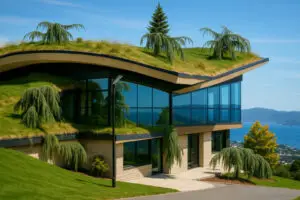
Living Walls Vertical Gardens: Where City Streets Breathe Again
Living Walls Vertical Gardens are rewriting the urban story across New Zealand and Australia. Step off a hot Auckland footpath, turn a corner, and a cool green façade greets you. Ferns, flax, and orchids climb skyward, filtering air and softening the hard edge of concrete. In that instant the city feels kinder and more human. These soaring gardens are not decoration; they are living infrastructure, healing the split between people and nature.
Green Walls as Urban Climate Shields
The numbers tell a powerful tale. Research from the Australian Government’s urban greening programme shows vertical vegetation can trim wall temperatures by up to 12 °C Australian Government urban greening data. The effect is most dramatic on summer days. Less heat means cooler streets, safer elderly residents, and lower energy bills. Brisbane’s Fish Lane proves the point. Its 410-square-metre green wall holds 9 000 native plants. The installation turned a forgotten alley into a rainforest corridor. Butterflies now drift where exhaust once lingered. Cafés report longer lunchtime queues because patrons choose the shaded lane over nearby sun-baked sidewalks. During blazing Queensland summers the wall acts as a climate shield. It absorbs glare, traps dust, and breathes moisture into the air.
A single-classroom living wall in West Auckland delights primary pupils every recess. Children mist the leaves, hunt for ladybirds, and learn that cities can nurture life. Teachers note calmer break times and a quiet pride as students watch their plants stretch upward week by week. Vertical gardens slip into the tightest footprints. They prove that even a postage-stamp of green can carry ecological punch.
Technology Behind the Tapestry
Today’s living walls hide impressive engineering beneath the foliage. Modular panels cradle lightweight growing media; embedded drip lines sip rainwater collected from the roof. In Melbourne, sensors send real-time moisture and nutrient data to a gardener’s phone. When plants grow thirsty, a solar-powered pump activates. The system wastes almost no water, an asset during drought years. These smart layers keep maintenance low and survival rates high. Contractors once worried that vines would damage façades. Modern systems anchor panels without piercing cladding, and root barriers prevent structural creep.
Designers now treat buildings as ecosystems. Hospitals in Perth weave vertical gardens into patient courtyards after studies linked greenery with faster recovery. Office managers in Sydney place interior living walls beside meeting rooms. Workers step out of tense negotiations and stand before cascading philodendrons. Heart rates drop; creativity returns. Each small encounter with nature seems trivial. Together they shape healthier, more resilient communities.
Growing a Culture of Vertical Green
Living Walls Vertical Gardens also spark social contagion. One resident plants a balcony herb wall; soon neighbours copy the idea. An entire apartment block blossoms, each household adding colour and scent to a larger mosaic. Photos flood social media, inspiring friends in Wellington and Hobart. City councils take notice, drafting incentives for community-led installations. The movement spreads not by mandates but by delight.
The benefits extend beyond aesthetics. Vertical gardens absorb stormwater, buffer wind, and create micro-habitats for birds and pollinators US EPA green infrastructure. As climate pressures mount, these layered greenscapes offer rapid, visible relief. They cool streets during record heat and trap particulate pollution. Some walls even grow salad greens for the café downstairs. Each wall shows that cities can adapt with green grace rather than more concrete.
Standing before a flowering façade, many people speak of emotion rather than engineering. “It feels like the city is giving me a hug,” says one Wellington commuter. She pauses beneath a blooming koru-patterned wall. That sentiment captures the deeper promise of vertical gardens. They reconnect us with living systems, nurture well-being, and invite wilder, kinder skylines.

Green Infrastructure Resilient Cities
Green Infrastructure Resilient Cities: Core Benefits Green Infrastructure Resilient Cities is indeed, more than a trend; it is the blueprint for cooler streets, cleaner water and thriving neighborhoods, manage storms and lift urban life. On the other hand, Ten years ago hot asphalt reflected dazzling glare, pipes overflowed every spring, and life hid indoors.